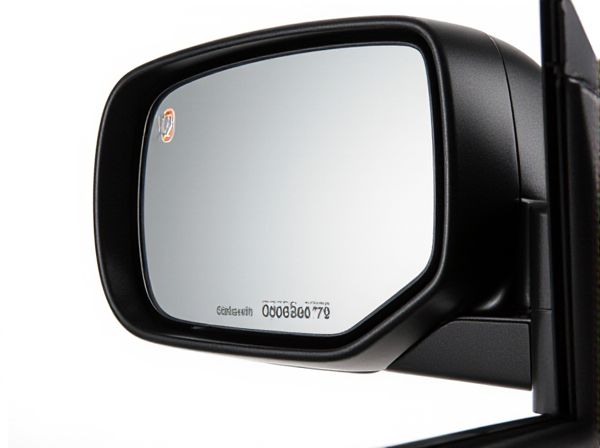
Photo illustration: Integrated Mirror vs Add-On Mirror
An integrated mirror is built directly into a device or vehicle, offering a seamless and streamlined appearance with enhanced durability. An add-on mirror is attached externally, providing flexible placement and easy replacement but may lack the sleek design of integrated models. Choosing the right option depends on your preference for aesthetics, functionality, and ease of installation.
Table of Comparison
| Feature | Integrated Mirror | Add-On Mirror |
|---|---|---|
| Design | Built into the vehicle's original design | Attached externally after manufacturing |
| Installation | Factory-installed, no extra setup | Requires manual installation |
| Durability | High, designed for vehicle specs | Variable, depends on quality and mounting |
| Aerodynamics | Optimized for minimal drag | Can increase air resistance |
| Cost | Included in vehicle price | Additional expense |
| Customization | Limited options | Wide range of styles and sizes |
| Maintenance | Low, designed for longevity | May require frequent adjustment or replacement |
| Compatibility | Specific to vehicle model | Universal or model-specific |
Introduction to Integrated vs Add-On Mirrors
Integrated mirrors are built directly into the vehicle's body, offering a streamlined design and enhanced aerodynamics, while add-on mirrors are externally attached accessories that provide flexible positioning and easy replacement. Integrated mirrors typically feature advanced functionalities like heating elements, turn signals, and auto-dimming, whereas add-on mirrors serve as cost-effective, customizable options primarily for improved visibility. Choosing between integrated and add-on mirrors depends on factors such as vehicle design, budget, and specific driving needs.
What Are Integrated Mirrors?
Integrated mirrors are built directly into the vehicle's design, often seamlessly incorporated within the door frame or body panel, enhancing aerodynamics and aesthetics. These mirrors typically feature advanced technologies like blind-spot detection, heating elements, and auto-dimming to improve safety and driver convenience. Unlike add-on mirrors, integrated mirrors reduce air drag and noise, contributing to better fuel efficiency and a streamlined vehicle profile.
Understanding Add-On Mirrors
Add-on mirrors are external attachments designed to enhance a vehicle's existing mirror system by providing additional viewing angles and reducing blind spots. These mirrors are typically easy to install, affordable, and customizable for specific driving requirements such as towing or lane changes. Unlike integrated mirrors, add-on mirrors do not alter the vehicle's original design but offer a flexible solution to improve safety and visibility.
Key Differences Between Integrated and Add-On Mirrors
Integrated mirrors are seamlessly incorporated into the vehicle's design, offering enhanced aerodynamics and reduced wind noise, while add-on mirrors are externally attached and can be customized or replaced independently. Integrated mirrors typically include advanced features like built-in turn signals and heating elements, whereas add-on mirrors may lack these functionalities or require aftermarket modifications. The choice between integrated and add-on mirrors affects vehicle aesthetics, functionality, and maintenance ease, with integrated mirrors generally providing a sleeker look and higher manufacturing costs.
Aesthetic Impact on Vehicle Design
Integrated mirrors seamlessly blend with a vehicle's overall design, enhancing aerodynamic flow and providing a sleek, modern appearance that complements the body lines. Add-on mirrors, often bulkier and more prominent, can disrupt the vehicle's aesthetic harmony and may appear as aftermarket modifications rather than integral components. The choice between integrated and add-on mirrors significantly influences the visual continuity and sophistication of automotive styling.
Installation and Compatibility Considerations
Integrated mirrors offer seamless installation as they are designed to fit specific vehicle models, ensuring perfect alignment and compatibility with existing systems such as power adjustment and heating. Add-on mirrors provide versatility by attaching externally, making them compatible with a wider range of vehicles but may require additional mounting hardware or modifications. Installation time for integrated mirrors is generally shorter due to factory design, while add-on mirrors might involve more complex adjustments to achieve proper fit and functionality.
Performance and Functionality Comparison
Integrated mirrors offer superior aerodynamic performance by reducing drag compared to add-on mirrors, improving fuel efficiency and high-speed stability. Their seamless design enhances driver visibility with minimal wind noise, while add-on mirrors tend to create turbulence and can obstruct sightlines due to their protruding structure. Functionally, integrated mirrors often include advanced features like heating elements and turn signal indicators, whereas add-on mirrors typically provide basic reflectivity without such enhancements.
Safety Features: Integrated vs Add-On Mirrors
Integrated mirrors offer enhanced safety by providing a seamless design that minimizes blind spots and reduces vibration for clearer visibility. Add-on mirrors, while customizable and easy to install, may suffer from instability and limited field of view, potentially compromising safety. Vehicles equipped with integrated mirrors benefit from manufacturer precision, ensuring compliance with safety standards and optimal mirror positioning.
Cost Analysis: Which is More Economical?
Integrated mirrors typically have higher upfront costs due to their seamless design and advanced features, offering long-term savings through reduced maintenance and enhanced durability. Add-on mirrors present a lower initial investment, but may incur additional expenses over time from repairs, replacements, and less efficient functionality. Evaluating the total cost of ownership reveals that integrated mirrors often provide a more economical solution for users prioritizing longevity and performance.
Choosing the Right Mirror Solution for Your Vehicle
Integrated mirrors offer a sleek, factory-designed look with built-in features like turn signals and heating elements, enhancing both aesthetics and functionality. Add-on mirrors provide a cost-effective alternative, ideal for vehicles lacking specific capabilities or when quick replacements are needed. Selecting the right mirror solution depends on your vehicle's compatibility, desired features, and budget considerations to ensure safety and style.
 caratoz.com
caratoz.com